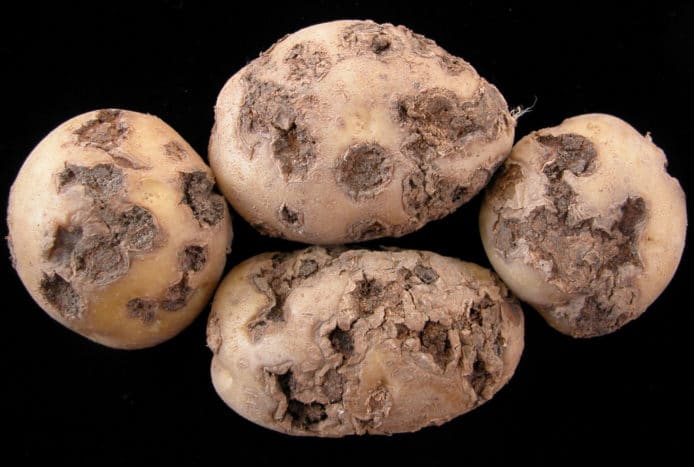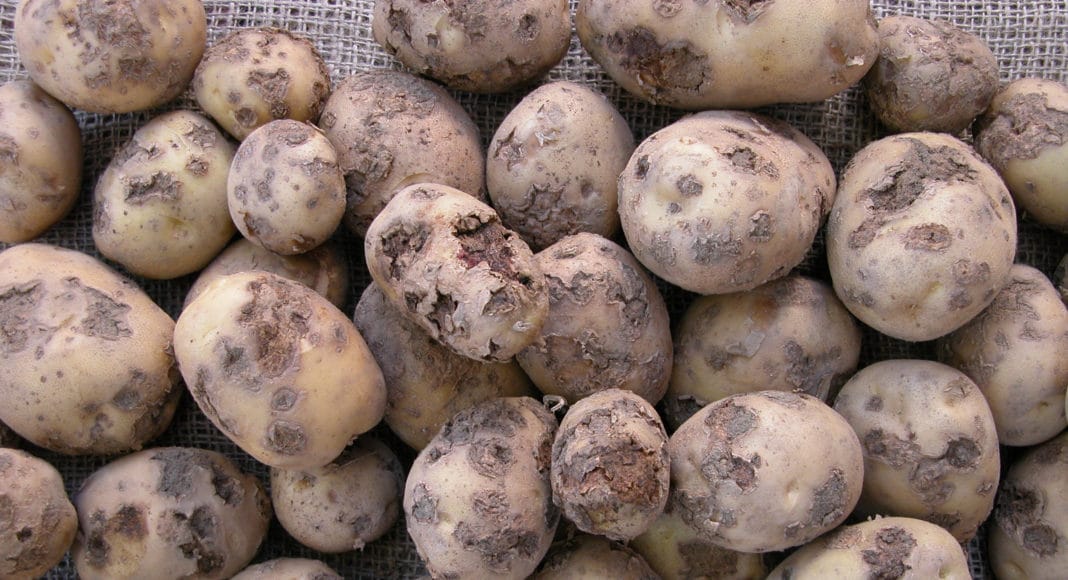Common scab continues to cause concern for potato growers.
Common scab, caused mainly by the seed and soil-borne bacterium Streptomyces scabies, continues to be a global concern for potato producers, especially for fresh market growers.
Common scab does not reduce yield, but the corky skin lesions render tubers unmarketable. Buyers demand a fresh market crop with smooth skin and no blemishes — in other words, a perfect potato. Processing potatoes with surface scab are marketable because tubers are peeled before frying. However, potatoes with pitted scab are usually rejected because pitting leaves cavities in the tubers.
The incidence and severity of scab varies from year-to-year and from field-to-field. Management practices to reduce scab have given inconsistent results. Gary Secor’s comment in 2007 at the first International Conference on Common Scab, which was held in Guelph, Ont. summed it up “The only issue that is consistent in control of common scab is the inconsistency of the control measures.” Only resistant varieties have proven to be reliable and effective.
There are several factors which explain why common scab has become such a problem:
- Spread of common scab on healthy seed — Potato growers avoid planting seed with visible symptoms of common scab to avoid introducing the bacterium to their farm. However, seed which looks healthy can carry the pathogen in the lenticels or on the tuber skin.
- Indefinite survival of S. scabies in soil as a saprophyte in the absence of potatoes.
- Soil conditions — Low organic matter and soil compaction are factors which reduce soil health and create an environment that is favourable for scab.
- Warmer, drier seasons more common now due to climate change favour scab development.
- Genetic variability — Some Streptomyces strains are extremely aggressive and can attack resistant varieties.
- Any potential treatment would need to be evenly distributed in two million lbs. of soil, which is the plow layer or top six inches of soil. (Robert Coffin’s comment at the International Conference on Common Scab)
It’s not surprising common scab has been called a problem without a solution. Resistant varieties are effective, but there are not always resistant varieties among those requested by the markets. Growers continue to search for management practices to reduce scab.

Charles Emre, a farmer near Simcoe, Ont. has been evaluating mustards and other rotational crops for several years. He says his rotational crop mixtures do not control scab, but they are keeping it at bay. Emre also keeps adequate soil moisture at tuber initiation and beyond — a practice which reduces scab in some fields but not in others.
Chloropicrin fumigation has reduced common scab very effectively in some fields, but not in others. Research is needed to determine why this happens.
Are there any chances to ever get an effective control method for common scab? According to Vikram Bisht, potato plant pathologist with the Manitoba government, a knowledge of local Streptomyces species/strains may prove to be essential. I agree with him.
A 2019 soil survey showed Streptomyces stelliscabiei was the predominant species found in Ontario, not S. scabies. S. stelliscabiei appears to be suppressed in fields with soil organic matter above four per cent.
The conditions under which the disease occurs is another factor which Vikram considers important. The type of scab (raised, superficial or pitted) depends on the potato variety, the environment, and the soil microbial community. It has proven to be difficult to identify the conditions which reduce common scab consistently.
Bisht suspects a biological seed treatment would be most efficient and cost effective, but a “one size fit all” approach is unlikely to work. A knowledge of local Streptomyces species/strains in fields would be necessary to determine which biologicals could work in the Maritimes, in Central Canada and the Prairies. A concoction of a few biocontrol agents could be more effective,
I tell growers to do their own research — treat a scabby section of a field with any method they think might control scab. It’s a practical way of testing scab management practices in their own fields on the varieties they grow. This increases the chance of finding an effective control method or a combination of methods to control scab.
Related Articles
Using Human Disease Strategies to Fight Common Scab
Advancing the Control of Potato Common Scab with Molecular Technology











